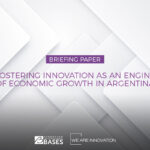The oil reserves of Venezuela, Brazil, Mexico, Argentina, Colombia, Ecuador, and Guyana are a competitive advantage for our region. However, political, climatic, and territorial barriers have led us to evaluate the usefulness of this resource in transport activity. Freight transport in Latin America is responsible for 40% of global carbon dioxide (CO2) emissions. This indicator leads decision-makers and researchers to act through international cooperation instruments such as Nationally Determined Contributions and National Adaptation Plans for Climate Change.
Based on this context, electric mobility, an approach to sustainable mobility that integrates electricity to drive the engines of transport means, is promoted. Not only to reduce greenhouse gas (GHG) emissions but also to promote multiple business models such as renewable energies integration on the energetic grid, charging infrastructure construction, battery manufacture and recycling, data collection, mobile application development, and sensor installation to measure CO2. Electric mobility is one of the main pillars of the global energy transition. In some Latin American countries, due to petroleum derivatives consumption, transport generates more than 40% of energy sector emissions.
Currently, 16.5 million electric vehicles are on the world’s roads. China accounts for 48% of this figure. Latin America does not exceed 5%. Even so, our countries have taken significant steps by creating public policies for electric vehicles introduction in public transport fleets and expanding the offer with more than 70 models available.
There is still a long way to go for electric mobility development in Latin America, but what are our main challenges?
Latin America has experienced the highest growth in vehicle registration worldwide, more than 50% between 2005 and 2015. It is also the second most urbanized region globally; 81% of the population lives in urban areas. Thus, it is not surprising that Bogotá, Lima, Medellín, and Quito citizens use public transport for more than half of their daily trips. Public transport accounts for more than 70% of daily trips in Mexico City and Panama City. These data reveal our first challenge: electric mobility implementation in public transportation, promoting passenger vehicles or electric trains to protect our city’s air quality.
There is a standard gap of B/.12,000.00 between the price of internal combustion vehicles and electric vehicles. The battery’s cost is crucial in ensuring the reduction of this amount. Li-ion batteries, currently the most efficient batteries, have lithium as their main component. The market value of Li-ion batteries is estimated to be B/.70 billion by 2026. Bolivia, Argentina, and Chile hold the world’s three largest lithium reserves, totaling 49.9 million tonnes.
From this favorable outlook for Latin America arises our second challenge: ensure sustainability in lithium extraction and strengthen innovation in battery manufacture to reduce environmental impact and electric vehicle prices parallel. Furthermore, recycling batteries must complement these actions to increase their second use and encourage the circular economy in electric mobility.
Often, the lack of charging stations for electric vehicles is one of the main fears of potential buyers. However, a 37% growth in installed units has been reported for 2021, totaling 1.8 million worldwide. The US Department of Energy forecasts a 38% increase in energy consumption due to electric vehicles introduction. This indicator could harm Latin American countries whose energy grid depends on fossil fuels.
Therefore, our third challenge is to prioritize the off-grid or renewable energy charging infrastructure development and explore vehicle-to-grid (VG2) technology, which allows the driver to sell energy to the grid.
Undoubtedly, innovation is the primary tool to address the three challenges mentioned above. Since 2010, E-hailing technologies (mobile applications and platforms such as Uber, Bird, and Rappi), semiconductors (microchips and chips), and AV sensors / ADAS components (multi-vision cameras, sensors to perceive the environment and hardware solutions) are the focus of investments in the mobility sector, totaling B/.124.2 billion. This underpins our fourth and final challenge: updating curricula and human capital training to increase Latin America’s participation in the development of electric mobility.
Latin America has all the tools and potential to position itself in the electric vehicle market. Although the political, climatic, and territorial barriers to fossil-fuelled transport remain, the socio-economic benefits of this technology and its progressive improvements will make it a battle for sustainable mobility.
* Alexander Ubaldo Gutiérrez is currently an Intern at Fundación Internacional Bases.
Originally published in Spanish at Somos Innovación
Source: We Are Innovation











